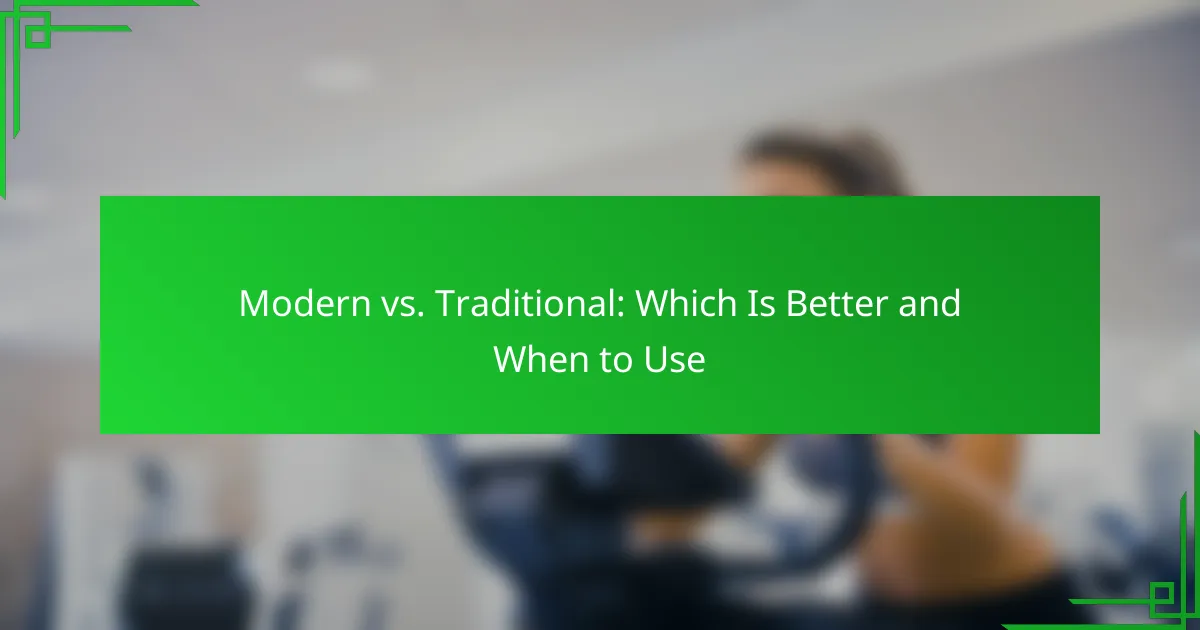In the debate between modern and traditional methods, the choice often hinges on the specific needs and goals of a project. Modern approaches prioritize speed, flexibility, and technological integration, making them ideal for dynamic environments. Conversely, traditional methods provide stability and proven effectiveness, which can be crucial for projects requiring established practices. Understanding these distinctions is key to selecting the most suitable approach for any given situation.

When should you choose modern methods over traditional methods?
Modern methods are preferable when speed, flexibility, and scalability are critical, while traditional methods excel in stability and proven effectiveness. Consider the specific needs of your project to determine the best approach.
Modern methods for efficiency
Modern methods often leverage technology to streamline processes, reduce time, and enhance productivity. For instance, agile project management allows teams to adapt quickly to changes, resulting in faster delivery times compared to traditional waterfall approaches.
Utilizing tools like cloud computing and automation can significantly cut costs and minimize manual errors. Companies can see improvements in efficiency by adopting these modern techniques, often achieving project completion in a fraction of the time.
Traditional methods for reliability
Traditional methods are grounded in established practices that have been tested over time, making them reliable for projects requiring consistency. For example, construction projects often rely on traditional techniques to ensure safety and compliance with regulations.
These methods can provide a clear structure and predictability, which is crucial in industries like healthcare or manufacturing where adherence to standards is vital. While they may take longer, the outcomes are often more stable and trustworthy.
Contextual factors influencing choice
When deciding between modern and traditional methods, consider factors such as project scope, industry standards, and team expertise. For instance, tech startups may benefit from modern methods due to their need for rapid iteration, while established firms in regulated sectors might prefer traditional approaches.
Budget constraints and timelines also play a significant role. If resources are limited, modern methods might offer more cost-effective solutions, whereas traditional methods may require more upfront investment but can yield long-term reliability.

What are the key differences between modern and traditional approaches?
Modern approaches emphasize flexibility and technology integration, while traditional methods focus on established practices and proven techniques. Understanding these differences can help determine which approach is more suitable for specific situations.
Technology integration in modern methods
Modern methods leverage advanced technologies such as artificial intelligence, cloud computing, and data analytics to enhance efficiency and decision-making. For instance, businesses often use software tools that automate processes, reducing the time spent on manual tasks.
When considering modern approaches, it’s essential to evaluate the technology’s compatibility with existing systems and the potential learning curve for staff. Organizations should ensure that the benefits of integration outweigh the costs and challenges of implementation.
Established practices in traditional methods
Traditional methods rely on time-tested practices and frameworks that have been refined over many years. These approaches often emphasize face-to-face interactions and structured processes, which can foster strong relationships and clear communication.
While traditional methods can provide stability and predictability, they may lack the adaptability required in rapidly changing environments. Organizations should weigh the benefits of consistency against the need for innovation and responsiveness to market demands.

How do modern and traditional methods compare in cost?
Modern methods often offer lower upfront costs and increased efficiency compared to traditional methods, which may have higher initial investments but can lead to significant long-term expenses. The choice between the two largely depends on the specific context and goals of the project.
Cost-effectiveness of modern solutions
Modern solutions typically leverage technology to reduce costs through automation and improved efficiency. For instance, cloud-based services can minimize infrastructure expenses, allowing businesses to pay only for what they use. This pay-as-you-go model can lead to savings of 20-30% compared to traditional setups.
Additionally, modern methods often require less maintenance and can be scaled easily, which further enhances their cost-effectiveness. Companies can adapt their resources based on demand, avoiding over-investment in unused capacity.
Long-term expenses of traditional methods
Traditional methods often involve significant upfront costs for equipment and infrastructure, which can lead to higher long-term expenses. Maintenance, labor, and operational costs can accumulate, sometimes reaching 50% more than anticipated over time. For example, a manufacturing facility using outdated machinery may incur high repair costs and downtime.
Moreover, traditional approaches may lack flexibility, resulting in additional costs when adapting to market changes. Businesses may find themselves investing in upgrades or replacements sooner than expected, further straining their budgets.

What are the advantages of modern methods?
Modern methods offer significant advantages, particularly in terms of efficiency and adaptability. They enable organizations to respond quickly to changing market demands and leverage advanced technologies for improved outcomes.
Increased flexibility and scalability
Modern methods provide enhanced flexibility, allowing businesses to adapt their processes and resources according to real-time needs. This is particularly beneficial for companies experiencing rapid growth or fluctuating demand.
For instance, cloud-based solutions can scale resources up or down with minimal effort, accommodating varying workloads without significant upfront investments. This flexibility helps organizations avoid overcommitting resources and reduces operational costs.
Enhanced data analytics capabilities
Modern approaches utilize advanced data analytics tools that enable organizations to gather, process, and analyze vast amounts of data efficiently. This capability allows for more informed decision-making based on real-time insights.
Companies can leverage predictive analytics to forecast trends and customer behaviors, which can lead to better-targeted marketing strategies and improved customer satisfaction. Investing in data analytics tools can yield substantial returns by optimizing operations and enhancing competitive advantage.

What are the advantages of traditional methods?
Traditional methods offer several advantages, including a proven track record and often lower initial costs. These approaches have been refined over time, making them reliable choices in various contexts.
Proven effectiveness over time
One of the main benefits of traditional methods is their established effectiveness. Many techniques have been tested and validated through years of use, providing a sense of security for practitioners. For example, in agriculture, crop rotation has been a staple for centuries, demonstrating its reliability in maintaining soil health.
When considering traditional methods, it’s essential to evaluate their historical success in your specific field. This can help in making informed decisions about which practices to adopt, especially when newer methods lack extensive data.
Lower initial investment
Traditional methods often require a lower initial investment compared to modern alternatives. For instance, using manual labor instead of advanced machinery can significantly reduce startup costs for small businesses. This makes traditional methods particularly appealing for startups or individuals with limited budgets.
However, while the upfront costs may be lower, it’s crucial to consider the long-term implications. Some traditional methods may require more time and labor, which could offset initial savings. Always weigh the short-term benefits against potential long-term expenses to determine the best approach for your situation.

How do user preferences vary between modern and traditional?
User preferences between modern and traditional methods often depend on factors such as convenience, familiarity, and effectiveness. Modern approaches tend to appeal to younger demographics seeking efficiency, while traditional methods may resonate more with older generations valuing established practices.
Trends in consumer behavior
Recent trends show a significant shift towards modern solutions, particularly in technology and communication. Consumers increasingly favor digital platforms for their speed and accessibility, often opting for online shopping, mobile banking, and social media interactions over traditional methods.
However, traditional methods still hold value in certain contexts, such as face-to-face interactions in customer service or local markets. Many consumers appreciate the personal touch and reliability associated with established practices, especially in sectors like healthcare and education.
Demographic influences on method preference
Demographics play a crucial role in determining whether users lean towards modern or traditional methods. Younger individuals, often more tech-savvy, typically prefer modern approaches, while older generations may feel more comfortable with traditional methods due to their familiarity.
Additionally, cultural factors can influence preferences. In regions where technology adoption is slower, traditional methods may still dominate. Understanding these demographic nuances can help businesses tailor their strategies to meet the preferences of their target audience effectively.

What are the risks associated with modern methods?
Modern methods often come with significant risks, including reliance on technology and potential data security vulnerabilities. Understanding these risks is crucial for making informed decisions about when to adopt modern practices.
Dependence on technology
Dependence on technology can lead to operational vulnerabilities. If systems fail or experience downtime, businesses may face disruptions that can impact productivity and revenue. For example, a company relying on cloud services may struggle if the provider experiences outages.
To mitigate this risk, organizations should have contingency plans in place, such as backup systems or alternative processes. Regularly testing these plans ensures that they can quickly adapt in case of technological failures.
Data security concerns
Data security concerns are a major risk associated with modern methods, as sensitive information is often stored and transmitted electronically. Breaches can lead to significant financial losses and damage to reputation. For instance, companies in the EU must comply with the General Data Protection Regulation (GDPR), which imposes strict requirements on data handling.
To protect data, businesses should implement robust security measures, such as encryption, regular security audits, and employee training on best practices. Additionally, staying informed about emerging threats can help organizations adapt their security strategies effectively.
